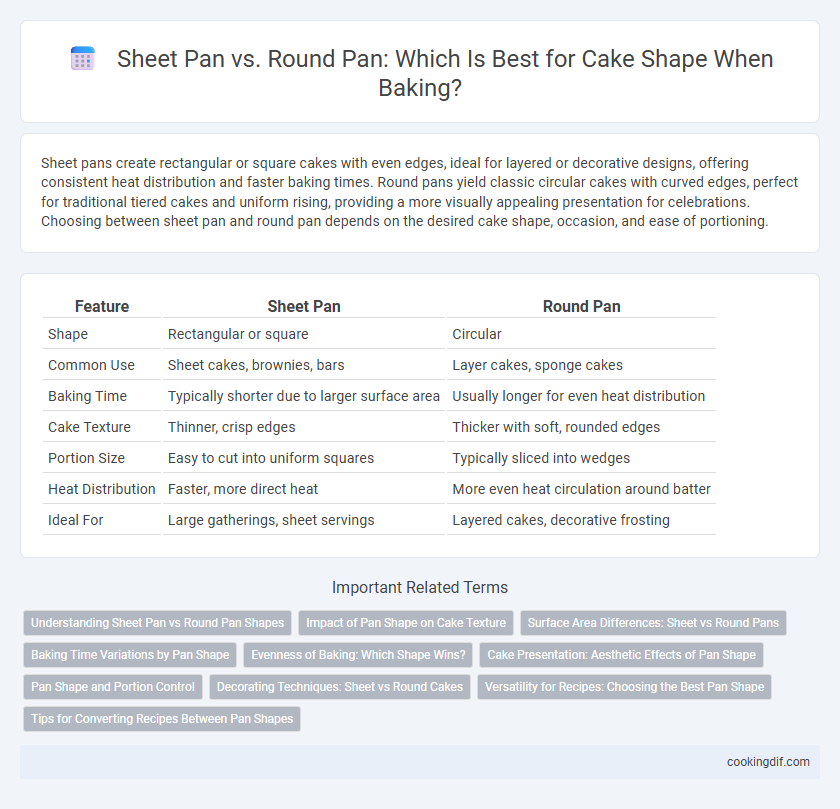Sheet pans create rectangular or square cakes with even edges, ideal for layered or decorative designs, offering consistent heat distribution and faster baking times. Round pans yield classic circular cakes with curved edges, perfect for traditional tiered cakes and uniform rising, providing a more visually appealing presentation for celebrations. Choosing between sheet pan and round pan depends on the desired cake shape, occasion, and ease of portioning.
Table of Comparison
| Feature | Sheet Pan | Round Pan |
|---|---|---|
| Shape | Rectangular or square | Circular |
| Common Use | Sheet cakes, brownies, bars | Layer cakes, sponge cakes |
| Baking Time | Typically shorter due to larger surface area | Usually longer for even heat distribution |
| Cake Texture | Thinner, crisp edges | Thicker with soft, rounded edges |
| Portion Size | Easy to cut into uniform squares | Typically sliced into wedges |
| Heat Distribution | Faster, more direct heat | More even heat circulation around batter |
| Ideal For | Large gatherings, sheet servings | Layered cakes, decorative frosting |
Understanding Sheet Pan vs Round Pan Shapes
Sheet pans provide a large, flat surface ideal for baking sheet cakes with even heat distribution, resulting in a uniform texture and faster baking times. Round pans create a thicker, taller cake layer with distinct edges, perfect for layered cakes and classic presentation styles. Choosing between sheet and round pans depends on the desired cake shape, texture, and serving style for the recipe.
Impact of Pan Shape on Cake Texture
Sheet pans produce cakes with a thinner, more uniform crumb due to their larger surface area, promoting even baking and a slightly crispier edge. Round pans encourage a denser, moister texture, as the heat distributes more evenly around the batter, reducing the likelihood of overcooked edges. The choice between sheet and round pans directly influences the cake's crumb structure and overall moistness, impacting the final eating experience.
Surface Area Differences: Sheet vs Round Pans
Sheet pans offer a larger surface area compared to round pans, allowing cakes to bake more evenly and develop a thinner crust. Round pans concentrate heat toward the center, often resulting in a thicker crumb and taller cake layers. Understanding these surface area differences helps bakers choose the right pan for texture and baking time precision.
Baking Time Variations by Pan Shape
Sheet pans promote faster baking due to their larger surface area and shallower depth, allowing heat to penetrate evenly and reducing overall baking time. Round pans require longer baking times as heat takes more time to reach the center, especially with deeper batter layers. Adjusting baking times based on pan shape ensures consistent cake texture and prevents undercooking or overbaking.
Evenness of Baking: Which Shape Wins?
Sheet pans promote more even baking due to their larger surface area and shallow depth, allowing heat to circulate uniformly around the batter. Round pans, with their curved sides and taller depth, often result in uneven heat distribution, causing the cake edges to cook faster than the center. For consistent texture and color, sheet pans typically outperform round pans in evenness of baking.
Cake Presentation: Aesthetic Effects of Pan Shape
Sheet pans create cakes with sharp, clean edges and a modern, minimalist aesthetic ideal for uniform slices and layered designs. Round pans offer a classic, elegant look with curved edges that enhance the cake's visual appeal, allowing smooth frosting application and decorative piping along the circumference. Choosing between these pans directly impacts cake presentation, influencing portion shape, decoration style, and overall visual impression.
Pan Shape and Portion Control
Sheet pans provide a rectangular shape that makes it easier to cut uniform portions, ideal for serving consistent piece sizes at gatherings. Round pans create a classic circular cake shape that offers a more traditional presentation but can complicate portion control due to varying slice sizes. Choosing between sheet pan and round pan depends on whether precise portion control or aesthetic presentation is the priority in your baking.
Decorating Techniques: Sheet vs Round Cakes
Sheet pans offer a large, flat surface ideal for intricate piping and spreading, making them perfect for simple, elegant designs or detailed borders. Round pans allow for tiered cakes and smooth, continuous frosting applications, enhancing sculpted decorations and layered aesthetics. Choosing between sheet and round pans depends on the desired decorating approach, with sheet cakes favoring expansive layouts and round cakes supporting three-dimensional creativity.
Versatility for Recipes: Choosing the Best Pan Shape
Sheet pans offer exceptional versatility for baking a wide range of cakes, brownies, and bars due to their large, flat surface area that promotes even cooking and easy portioning. Round pans excel in traditional cakes and layered desserts, providing uniform heat distribution and a classic presentation ideal for frosting and decorating. Selecting between sheet and round pans depends on recipe requirements, desired cake shape, and ease of serving, with sheet pans favored for multi-serving treats and round pans preferred for structured, elegant cakes.
Tips for Converting Recipes Between Pan Shapes
When converting recipes between sheet pans and round pans, adjust the baking time and temperature to prevent overbaking or undercooking; sheet pans typically require lower temperatures and shorter times due to greater surface area exposure. Use an oven thermometer to monitor consistent heat distribution and check doneness by inserting a toothpick in the center, especially when converting deeper round pan recipes to shallower sheet pans. To maintain batter volume and texture, scale ingredient quantities proportionally based on pan size and depth, ensuring even baking and desired cake crumb.
Sheet Pan vs Round Pan for baking shape Infographic

 cookingdif.com
cookingdif.com